Stone Age
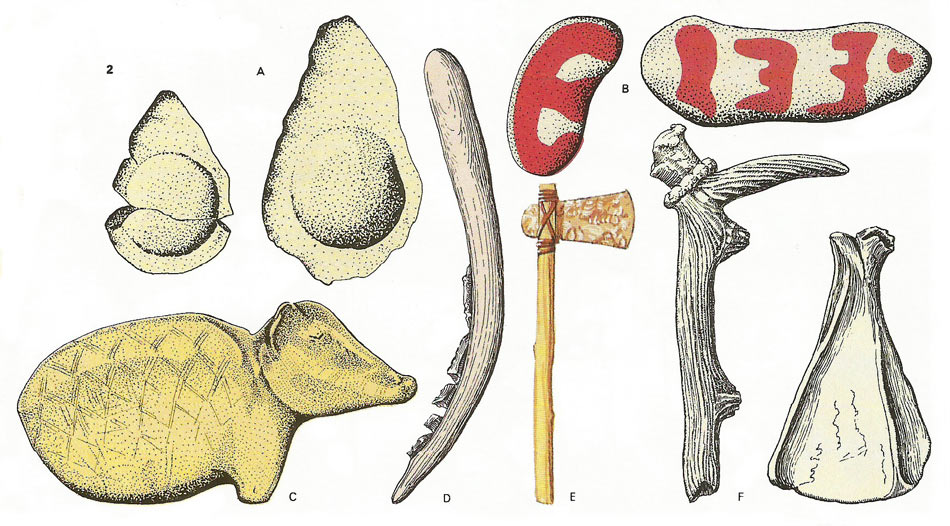
From the late Old Stone Age to the time of his settling down the Neolithic or New Stone Age man worked in a number of materials and made many kinds of objects. The cave painters made small household objects such as the stone lamps (A) which date from 15,000 BC. The painted pebbles (B) of the Mesolithic Azilian culture date from 10,000 BC and may be toys or magical objects. Also Mesolithic, but from the Maglemosian culture of 8000–5000 BC, are decorative animals carved in amber (C). Neolithic tools were often elaborately manufactured as in this flint-bladed bone-handled sickle of about 5000 BC (D). Antlers were used as picks and ox shoulder blades as shovels (F). Stone tools were used until later times in Britain. A good example is the stone-headed axe (E).
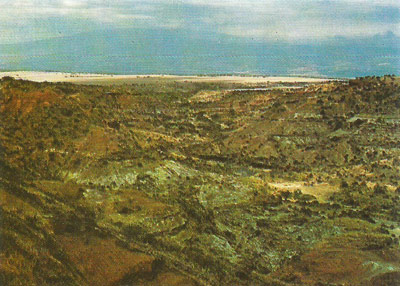
Humans first evolved in Africa. Human-like fossils were dug up in the Olduvai Gorge of Tanzania by Louis Lea key in 1958, some dating from 1.8 million years ago.
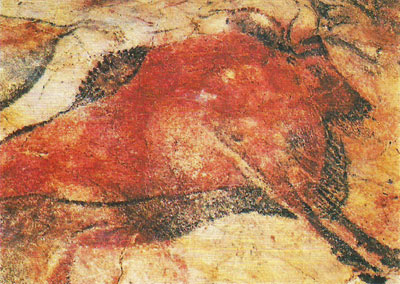
Man was an artist 20,000 years ago – but his paintings also carried a magical significance. This example is from the cave paintings at Altamira, Santander in Spain, which showed various animals, and were the first to be recognized as Paleolithic.
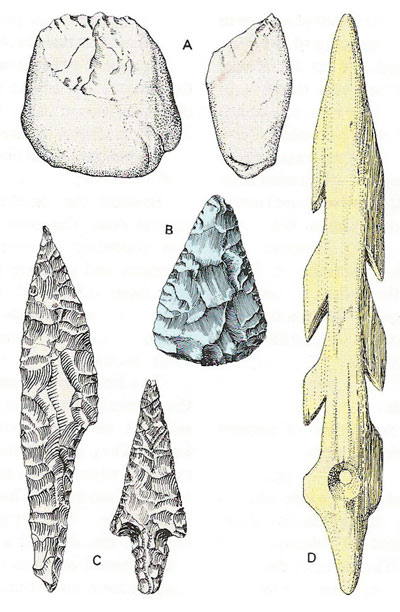
The earliest tools of ancient man were crude stone hand axes some of which (from east Africa) (A) are nearly two million years old. Much later, about 50,000 years ago, Neanderthal man made stone hand axes of a more sculptured kind (B). These were shaped by being hammered carefully with another stone, Later in the Old Stone Age, about 18,000 BC, Solutrean hunters were making very elegant scrapers and arrowheads (C). by about 15,000 BC Homo sapiens was also an expert fisherman who carved bone harpoons (D). This was the time of Cro-Magnon man, who was physically indistinguishable from the various races of modern man.
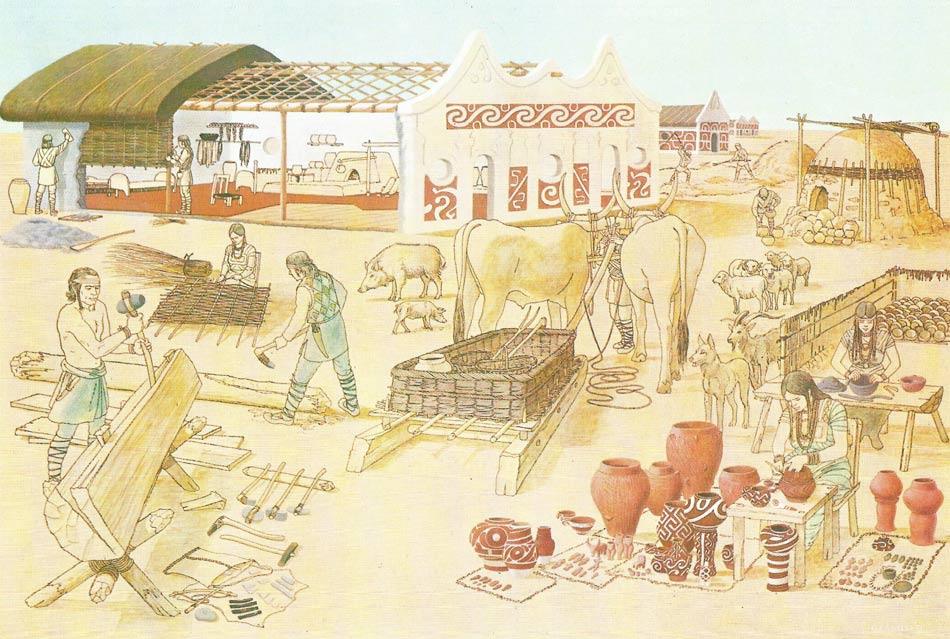
At Habasesti, a site in Romania dating from 3000 BC, edged tools such as axes and hoes are made of stone and sickles are edged with flint. Thus the site belongs to the New Stone Age. But ornaments and tools of copper are also found. Perhaps these are copies of items imported from Anatolia to the east, which was already in the Bronze Age. Habasesti shell ornaments, with holes for stringing, are probably also copies but this time from the ornaments of visiting Mediterranean peoples. Neolithic villages of the European forest-steppe zones were often larger than English villages 4,000 years later: Habasesti contains remains of 44 longhouses, each of which could house 500 people. But these were probably built and occupied over a long period by a smaller number of people. The longhouses had walls of clay on a framework of tree branches. Roofs were reed and thatch. House furnishings in these villages were often surprisingly sophisticated. The pottery vessels of Habasesti bear a distinctive S-shaped design. They were painted on red and white bases and outlined by channelled grooves and white, black, and red paint. They were fired, together with many small animal and human clay figures, in top-draft kilns. The Habasesti settlers were farmers who raised wheat and other grains, and vetches, and kept cattle, goats, pigs, and dogs. The remains of roe deer and wild pigs show, however, that the settlers also hunted for food. Their lives were busy and prosperous because the settled life allowed them to collect a surplus of food, weapons, and ornaments. Life at Habasesti also had its dark side: defensive ditches dug around the settlement show that attack was likely.
The Stone Age was the stage in man's cultural development preceding the Bronze Age and the Iron Age. It is characterized by use of exclusively stone tools and weapons, though some made of bone, wood, etc., may occur. It is split up into three periods: the Paleolithic, or Old Stone Age, began with the emergence of human-like creatures, the earliest stone tools being some 2.3 million years old and associated with the australopithecines. Paleolithic tools, if worked at all, are made of chipped stone. The Mesolithic, or Middle Stone Age, was confined exclusively to north-west Europe. Here between c. 8000 and c. 3000 BC, various peoples enjoyed a culture showing similarities with both Paleolithic and Neolithic. In Europe, the Neolithic, or New Stone Age, began about 8000 BC, and was signaled by the development of agriculture, with consequent increase in stability of the population and hence elaboration of social structure. The tools of the period are of polished stone. Apart from farming, the men also worked mines. The Neolithic merged slowly into the Early Bronze Age.
The Stone Age in Europe
In Europe a series of ice ages continued until only 10,000 years ago when the ice sheets finally began to retreat northwards. Human fossils from the first half of the Stone Age are rare, but it seems likely that the type of human called Homo erectus gradually gave way to, or evolved into, a number of later types of which only one, Homo sapiens or modern man, has survived. Human artefacts of this long period of the middle Paleolithic include improved types of stone flake tools. These are associated with the Loveliness culture of the middle Paleolithic, located around Levallois-Perret on France.
About 30,000 years ago the last type of human recognizably different from Homo sapiens (although it is sometimes classified within this species) became extinct. This was Neanderthal man who had a stooping posture, heavy brow ridges, and a sloping forehead, but whose brain was as large as ours. The Neanderthals are associated with the Mousterian culture of the middle Paleolithic, located in the region of the River Vérère in southwest France. They made fire and elegant hand axes and buried their dead with funeral rites.
The rest of the Paleolithic is the story of the prehistoric cultures of Homo sapiens : the Aurignacian of the upper Paleolithic, located at Haute Garonne, France; Gravetuan of the upper Paleolithic, located on the Dordogne, France; Solutrean of the upper Paleolithic, located at Saône-et-Loire, France; and Magdalenian cave dwellers of the upper Paleolithic, located in the region of the River Vérère, France.
Sophisticated artefacts
Weapons of these cultures were often finely made. The Solutreans were particularly sophisticated toolmakers. But humans were also becoming creative in a totally new way: they began to making carvings representing people and cave paintings of animals.
The carvings were dumpy "Venuses" that possibly had a magical significance. The cave paintings at Lascaux in France and Altamira in Spain, both of the Magdalenian culture, probably served magical purposes connected with hunting.
The Mesolithic, lasting from 10000 to 7000 BC in the Near East and later in Europe, was a time of great changes. The end of the Ice Age freed men to wander: indeed, it forced them to, because the game animals spread out from local areas and became more difficult to hunt. In the milder European climate forests sprang up. The Maglemosian culture (located at Maglemose, Denmark) associated with these forests produced some carvings that were purely decorative.
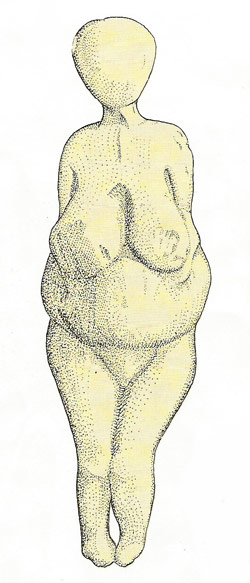 |
| This 'Venus', carved from a mammoth bone, is from the Gravettian culture of the Old Stone Age. It was one of 43 figures found at Kostienki in southern Russia. It is a fertility symbol and refers to the fertility of both woman and the earth.
|
People of these cultures also made simple stone vessels including lamps. They used flint, bones, and antlers as materials for tools and they probably worked in wood and leather as well, although these materials have not survived. In a later culture the Azilian people (located at Ariège, southwest France) of the Mesolithic – the Middle Stone Age – made objects such as painted pebbles.
Humans – settled and nomadic
From 7000 to 5000 BC, in the equable climates of Turkey and Mesopotamia, tribes that had been nomadic began to settle down in the first villages and raise animals and grow crops for food. This was the beginning of the Neolithic, or New Stone Age. In the fertile plain between the Tigris and Euphrates rivers, this village life eventually gave rise to the first great city civilization, Sumeria.
In the Near East the Stone Age lasted only until 3500 BC after which, as people learned how to smelt metals, it gave way to the Bronze Age. In more backward northern Europe the Neolithic persisted until about 2000 BC. Intermediates were such village cultures as that at Habaseti in Romania.
The Neolithic was also a time of great migrations of peoples, particularly those eastwards and westwards from southwest Russia. These people spoke the language from which many Eastern and nearly all European languages have since descended.
In the West the Neolithic wanderers left behind many weapons and tools of stone and bone as well as clay vessels and toys. More impressively, they left behind, from the Mediterranean to northern Europe, massive stone blocks arranged in lines and circles erected for astronomical or perhaps religious purposes. These stones (megaliths), such as Stonehenge, are the last great relics of the Stone Age and were probably used to calculate the times of sunrise and sunset at various seasons of the year.
